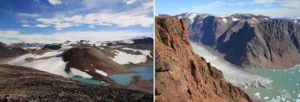
Ancient volcanoes dating back billions of years could provide new insights into how the Earth’s surface is recycled, according to scientists at the University of St Andrews.
A study, published today in Nature Communications, reveals the fate of the Earth’s ancient crust and could help solve the mystery of how the Earth’s surface and mantle are connected.
The Earth’s outermost layer is made up of rigid tectonic plates which move around and collide at regions called subduction zones.
In areas of collision, crustal materials get transported into the deep mantle, and one of the grand challenges in Earth Sciences is to understand what happens to this crust and how long it resides in the mantle.
At a few volcanoes on Earth geologists can find traces of these ancient crustal materials in the erupted lava. To date most of this work has focused on oceanic islands like Hawaii or the Canaries.
However, oceanic islands are only present at the surface of the Earth for a few million years before they themselves subside and are subducted back into the mantle, and so can only provide a tiny snapshot of crustal recycling over the four billion years of Earth history.
The St Andrews team investigated a suite of alkaline magmas erupted in continental rifts similar to the modern day East African rift.
Although these magmas have very unusual chemistries, they show many similarities with those oceanic lavas and, crucially, are found throughout Earth’s geological record.
The team focused on an alkaline province in south-west Greenland using cutting-edge isotope techniques to chemically fingerprint ancient crustal material in the source of these magmas.
Through a combination of remote field work (by boat and helicopter) and careful chemical analysis the team was able to show that these magmas were tapping into ancient crust subducted into the mantle 500 million years before the volcanoes started erupting.
Once the team understood these processes in Greenland they compiled a global data on alkaline magma chemistry and were surprised to find that the vast majority contained a recycled crustal component in their magma source.
Lead author Dr. Will Hutchison, from the School of Earth and Environmental Sciences at the University, said: “Our key result is that the isotopes of alkaline magmas are highly variable and this suggests that their recycled crustal sources have changed through geological time.
“The beauty of our global dataset is that it extends back over two billion years and so these unique alkaline rocks represent an extremely powerful record for understanding crustal recycling over Earth history.”
“By carefully bringing together the igneous and sedimentary isotope records, this might allow us to understand how changing crustal input is tied to volcanic output, and ultimately build a much better understanding of what happens to tectonic plates once they get transported into the deep Earth.”
Reference:
William Hutchison et al. Sulphur isotopes of alkaline magmas unlock long-term records of crustal recycling on Earth, Nature Communications (2019). DOI: 10.1038/s41467-019-12218-1
Note: The above post is reprinted from materials provided by University of St Andrews.










